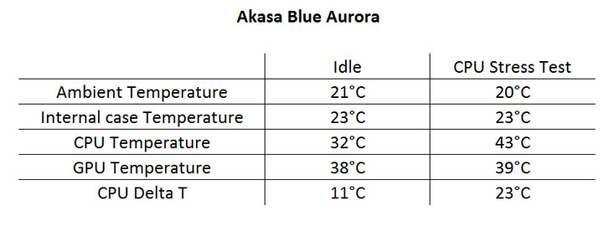Testing
As per usual, we fitted the Blue Aurora onto our notoriously toasty test system and mounted it into our heatsink testing chassis, a Lancool metal Boned K7. This case uses a fairly standard front to back dual 120mm intake / solo 120mm outtake cooling setup to cool our hardware, and we feel represents an “average” home cooling setup.Following our standard heatsink testing methodology, we then run idle and CPU stress tests three times, including fully re-fitting the heatsink between tests to ensure we eliminate any potentially erroneous results caused by variables in the mounting process. These variables could include differences in the tension of the mounting bracket, consistency and amount of thermal paste applied or improper mounting and can seriously compromise the accuracy of test results.
We use the results from the three separate test runs to create a set of average temperatures - that's exactly what you're seeing here in our results tables. We order our results based on the delta T value of the CPU under load – this means the difference between the ambient temperatures that we tested in, and the highest CPU temperature recorded.

The Blue Aurora certainly didn't disappoint in our thermal testing, and comfortably positions itself inside our top five performers, with just a degree between it and the Sunbeamtech Core-contact freezer under load. While we weren't exactly surprised to see the Blue Aurora perform so well, thanks to its beefy quad heat pipe display and numerous tightly packed heatpipes, it was still pleasing to see the Akasa cooler flying high with our other top performers and notching up a delta T at load of just 23°C.
The positive performance continued when it came to accessing the Blue Aurora's noise levels, with the 120mm cooling fan only just audible above our test case's cooling fans whilst at full speed. While still not as quiet as any of the ultra low noise Noctua 120mm fans we have in the office, the Blue Aurora's cooling fan was noticeably quieter than the Sunbeamtech, and was certainly running at a tolerable noise level. While it could be quieter, it's by no means intrusively loud.

MSI MPG Velox 100R Chassis Review
October 14 2021 | 15:04









Want to comment? Please log in.